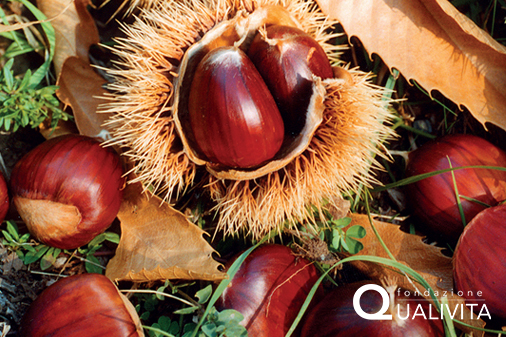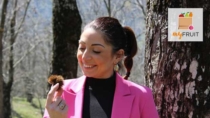Description
The Marrone di Serino/Castagna di Serino PGI refers to the fresh, peeled, dried in-shell and whole dried shelled fruit of the species Castanea Sativa Miller, of the Santimango or Verdola varieties.
Production Area
The production area of Marrone di Serino/Castagna di Serino PGI is within the municipalities of Serino, Solofra, Montoro, S. Michele di Serino, S. Lucia di Serino, S. Stefano del Sole, Sorbo Serpico, Salza Irpina, Chiusano S. Domenico, Cesinali, Aiello del Sabato, Contrada and Forino in the Province of Avellino, and the municipalities of Giffoni Valle Piana, Giffoni Sei Casali, S. Cipriano Picentino, Castiglione del Genovesi and Calvanico in the Province of Salerno, in the Campania region.
Production Method
The chestnut trees grow in lime-free volcanic soil that is rich in mineral elements, associated with the high level of humidity caused by the presence of large aquifers. A high-density planting system is used. The trees must be pruned at least once every 5 years in order to improve the quality of the product and guarantee regular vegetative renewal. The soil is not touched after planting, so as to promote an abundant growth of turf. Only mechanical and/or physical weed control is allowed in the chestnut groves; chemical weed control is not permitted. Only organic fertilisers can be used for fertilization, while pest control measures can only be carried out in the groves if they are included in the integrated phytosanitary measures set out in the Campania Region’s plan and the regulations in force. The fruit must be harvested in the period between September 25th and November 5th, and it must be carried out by hand or with suitable mechanical harvesters. The maximum annual production of fruit is set at 3 tonnes per hectare. Sorting and grading are carried out both manually and with mechanical graders.
Appearance and Flavour
Marrone di Serino/Castagna di Serino PGI is a medium-large sized chestnut with a star pattern; it rarely has any grooves. It is usually roundish and for the most part asymmetrical. The skin is brown and shiny with well-defined dark streaks that are spaced apart. The pulp is milky white, with fairly superficial grooves, firm and crunchy. It usually has a sweet flavour.
History
Cultivated chestnut groves have been present in the production area since Roman times, despite archaeological studies showing that there was already a widespread presence of chestnut trees in the Serinese valley in the Palaeolithic. In the Middle Ages, thanks to the work of the monks in both Cava dei Tirreni (SA) and Montevergine (AV), chestnut growing permeated the social stratum, becoming a characterising element of the entire production area. There are also juridical reports from 1532 which prove there were already fruit producing chestnut groves in Serino at the time, and that in 1548 some chestnut groves were sold in S. Stefano del Sole.
Gastronomy
Marrone di Serino/Castagna di Serino PGI should be kept in a cool, dry place. The fresh fruit are mainly used to make boiled and roasted chestnuts or marrons , and for the preparation of jams and marron glacé. The dried chestnuts or marrons, with or without the shell, are mainly eaten in the form of "marroni del prete" (priest’s marrons), a typical recipe in the production area.
Marketing
The product is marketed as Marrone di Serino/Castagna di Serino PGI, in the following varieties: fresh, dried, semi-processed or transformed. They can be sold vacuum-packed, in a protective atmosphere, and frozen. The packets vary in weight depending on the type of product, ranging from a minimum of 100 g to a maximum of 25 kg.
Distinctive Features
Marrone di Serino/Castagna di Serino PGI has unique chemical-physical sensory characteristics that are basically given to two factors: the lime-free volcanic soil that is rich in mineral elements and extremely fertile, associated with the high level of humidity caused by the presence of large aquifers; and the evolution of the chestnut tree due to the constant increase of funds, and the improved quality of the product thanks to the chestnut growers.










